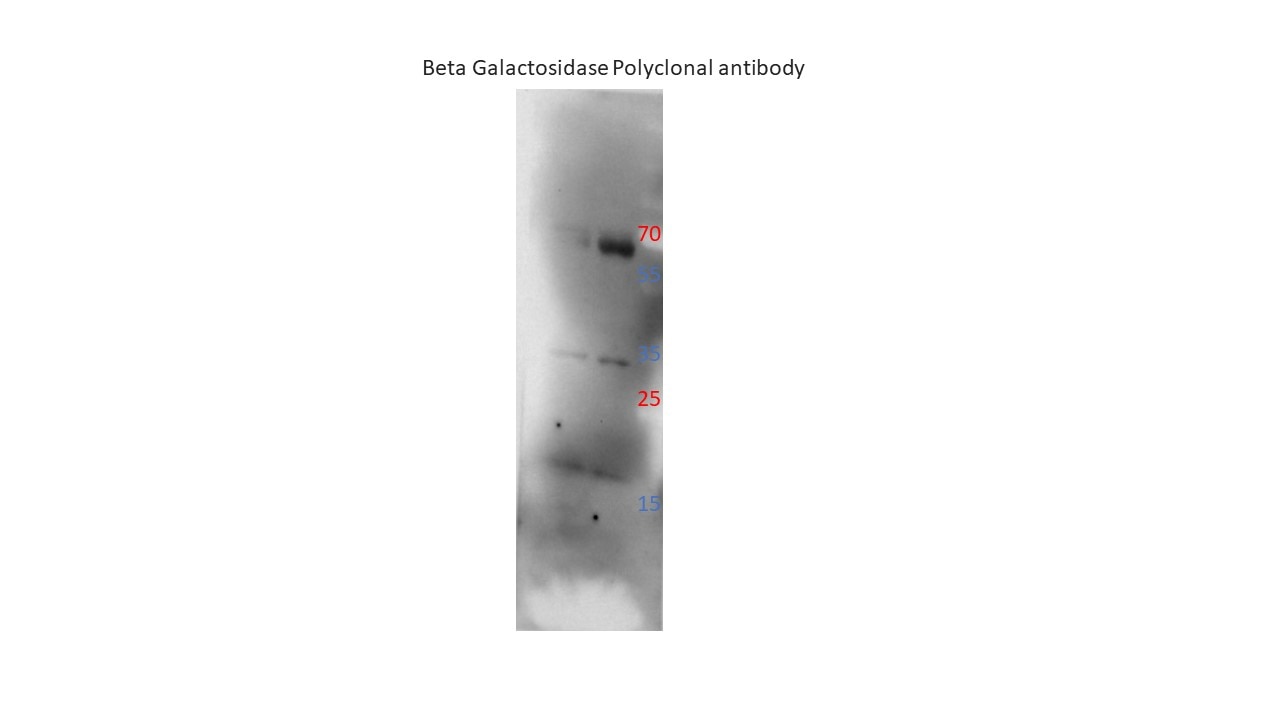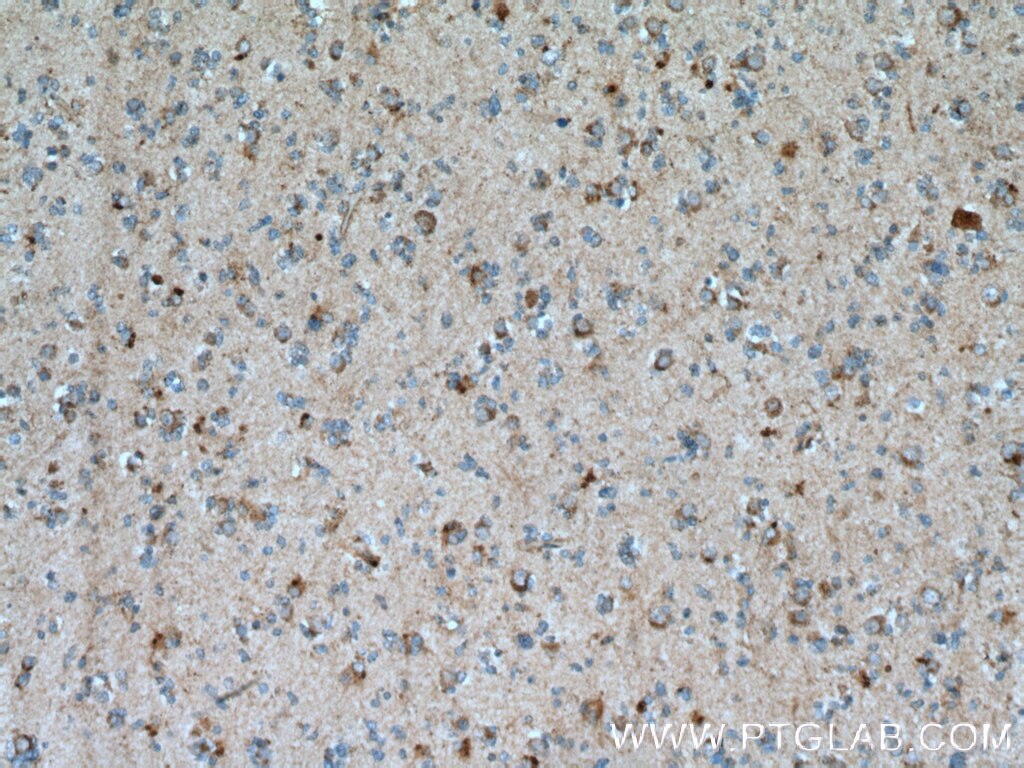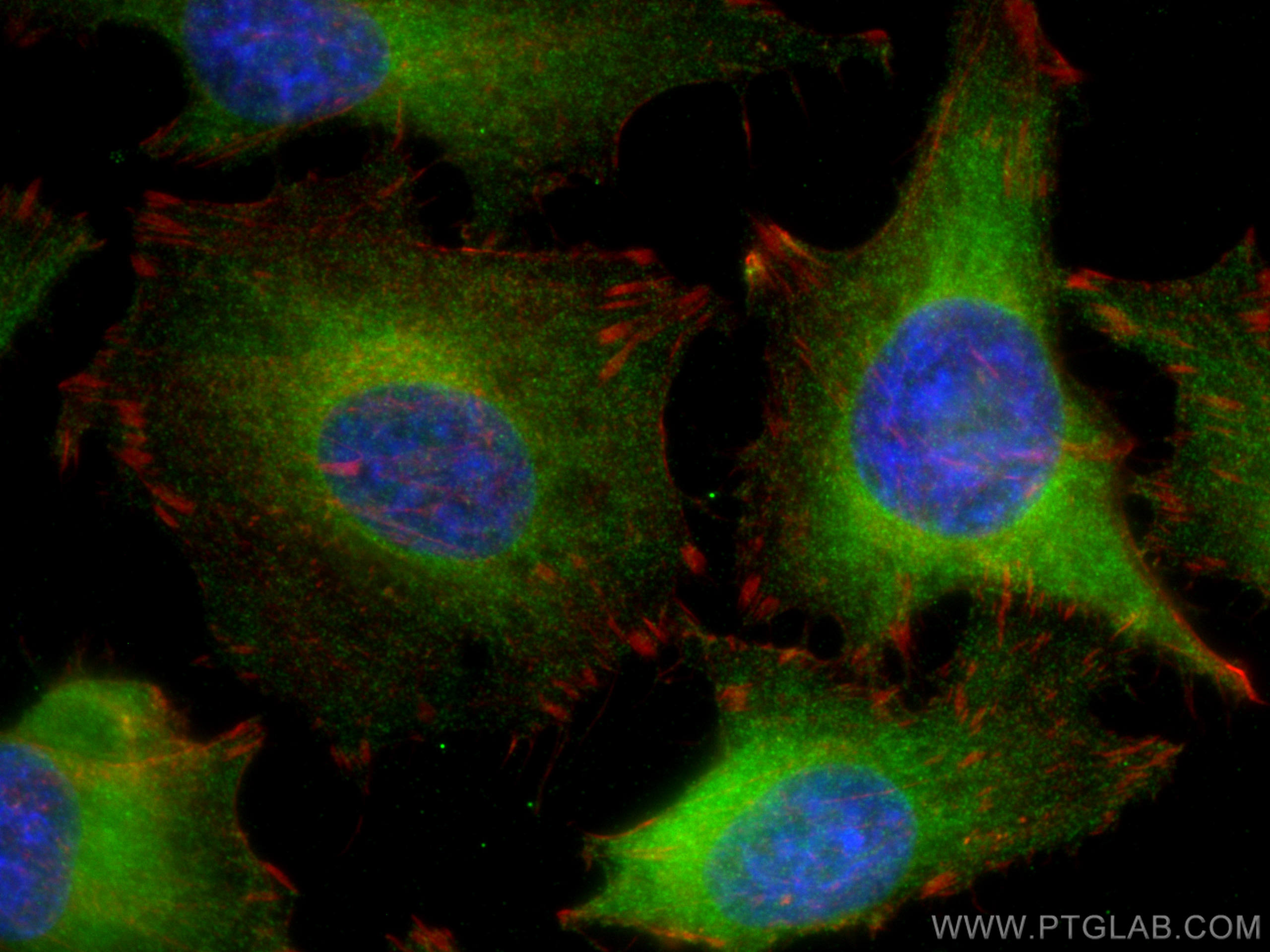Anticorps Polyclonal de lapin anti-Beta Galactosidase
Beta Galactosidase Polyclonal Antibody for WB, IHC, ELISA, IF/ICC
Hôte / Isotype
Lapin / IgG
Réactivité testée
Humain, souris et plus (2)
Applications
WB, IP, IHC, ELISA, IF/ICC
Conjugaison
Non conjugué
N° de cat : 15518-1-AP
Synonymes
Galerie de données de validation
Applications testées
| Résultats positifs en WB | cellules SH-SY5Y |
| Résultats positifs en IHC | tissu de gliome humain, tissu de cancer du foie humain il est suggéré de démasquer l'antigène avec un tampon de TE buffer pH 9.0; (*) À défaut, 'le démasquage de l'antigène peut être 'effectué avec un tampon citrate pH 6,0. |
| Résultats positifs en IF/ICC | cellules HeLa, |
Dilution recommandée
| Application | Dilution |
|---|---|
| Western Blot (WB) | WB : 1:500-1:1000 |
| Immunohistochimie (IHC) | IHC : 1:20-1:200 |
| Immunofluorescence (IF)/ICC | IF/ICC : 1:50-1:500 |
| It is recommended that this reagent should be titrated in each testing system to obtain optimal results. | |
| Sample-dependent, check data in validation data gallery | |
Applications publiées
| WB | See 20 publications below |
| IHC | See 10 publications below |
| IF | See 7 publications below |
| IP | See 1 publications below |
Informations sur le produit
15518-1-AP cible Beta Galactosidase dans les applications de WB, IP, IHC, ELISA, IF/ICC et montre une réactivité avec des échantillons Humain, souris
| Réactivité | Humain, souris |
| Réactivité citée | rat, bovin, Humain, souris |
| Hôte / Isotype | Lapin / IgG |
| Clonalité | Polyclonal |
| Type | Anticorps |
| Immunogène | Beta Galactosidase Protéine recombinante Ag7792 |
| Nom complet | galactosidase, beta 1 |
| Masse moléculaire calculée | 76 kDa |
| Poids moléculaire observé | 67 kDa |
| Numéro d’acquisition GenBank | BC007493 |
| Symbole du gène | GLB1/Beta-galactosidase |
| Identification du gène (NCBI) | 2720 |
| Conjugaison | Non conjugué |
| Forme | Liquide |
| Méthode de purification | Purification par affinité contre l'antigène |
| Tampon de stockage | PBS avec azoture de sodium à 0,02 % et glycérol à 50 % pH 7,3 |
| Conditions de stockage | Stocker à -20°C. Stable pendant un an après l'expédition. L'aliquotage n'est pas nécessaire pour le stockage à -20oC Les 20ul contiennent 0,1% de BSA. |
Informations générales
What is the molecular weight of β-galactosidase (GLB1)?
The molecular weight of GLB1 is 76 kD, although this protein is known to have multiple isoforms with lower
molecular weight values.
What is the function of GLB1?
The common name of β-galactosidase is lactase. This enzyme is responsible for catalyzing the hydrolysis of
lactose to monosaccharide glucose and galactose. GLB1 also catalyzes hydrolysis of polymeric D-galactosyl
residues (PMID: 23526073, doi: 10.1088/1757-899x/263/2/022046).
How is GLB1 used in our food?
GLB1 isolated from bacteria, fungi, yeast, plants, and other sources has been applied to the manufacturing
of lactose-hydrolyzed products (PMID: 28500401).
How is GLB1 part of a positive feedback loop?
GLB1 transgalactosylates lactose, resulting in allolactose. Allolactose is the inducer for the lac operon and
binds to the lac repressor, prompting GLB1 synthesis (PMIDs: 23526073, 28500401, 26394634).
What organisms express GLB1?
GLB1 is ubiquitous in nature and is produced across kingdoms in plants, microorganisms, and animals.
Properties, such as optimal pH range and temperature preference, vary between species; fungal GLB1
prefers acidic conditions, while yeast and bacteria have optimal conditions at more neutral pH values
(PMID: 28500401).
How is GLB1 utilized in transgenic animals?
Bacterial GLB1 is a widely used reporter gene in transgenic or knockout animals. The lacZ gene of E. coli
has been used to identify cis-acting DNA elements that play a key role for the regulation of gene expression
in mice. The lacZ gene can be incorporated into an endogenous gene, and it is frequently a used to indicate
the success of Cre-loxP recombination events, which allows temporal control of lacZ expression. Mice a
part of the Rosa26R line that also express Cre ubiquitously express Cre-inducible lacZ (PMID: 26394634).
Protocole
| Product Specific Protocols | |
|---|---|
| WB protocol for Beta Galactosidase antibody 15518-1-AP | Download protocol |
| IHC protocol for Beta Galactosidase antibody 15518-1-AP | Download protocol |
| IF protocol for Beta Galactosidase antibody 15518-1-AP | Download protocol |
| Standard Protocols | |
|---|---|
| Click here to view our Standard Protocols |
Publications
| Species | Application | Title |
|---|---|---|
Environ Int HIF-1α/m6A/NF-κB/CCL3 axis-mediated immunosurveillance participates in low level benzene-related erythrohematopoietic development toxicity | ||
J Cachexia Sarcopenia Muscle Sarcopenia is attenuated by TRB3 knockout in aging mice via the alleviation of atrophy and fibrosis of skeletal muscles. | ||
Theranostics Herb-sourced emodin inhibits angiogenesis of breast cancer by targeting VEGFA transcription. | ||
Cancer Lett Legumain-deficient macrophages promote senescence of tumor cells by sustaining JAK1/STAT1 activation. | ||
Arterioscler Thromb Vasc Biol β1-Integrin Is Essential for Vasoregulation and Smooth Muscle Survival In Vivo. |
Avis
The reviews below have been submitted by verified Proteintech customers who received an incentive forproviding their feedback.
FH Brice-Emmanuel (Verified Customer) (12-18-2023) | Work well in WB
 |
FH Lin (Verified Customer) (02-24-2022) | It is good for WB.
|
FH Lin (Verified Customer) (06-04-2021) | It works for skin IHC.
|








